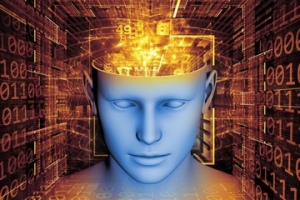Let’s look at two forces of attraction that are happening in the technology space, specifically looking at creating true artificial intelligent systems, utilizing advances in both software and hardware technologies.
For years, even decades we have chased it. AI has been at the top of any list of research interest groups, and while there have been some advances, the pertinent challenge has been that advances in hardware electronics in the 70’s and 80’s occurred, software design was lagging behind. Then, software advanced incredibly in the past decade. So now, in July 2015, we reach a key point of intersection of two “brain based technologies”, which could be built together in a way that may lead to “true AI”.
At no other point in history have we had both hardware and software technologies that can “learn” like we can, whose design is based on how our mind functions.
Numenta
First, let’s look at Numenta. Apart from having the pleasure of reading Jeff Hawkins excellent book “On Intelligence”, I have started to look at all the open source AI algorithms ( github here) that they provide. In a journey that start nine years ago, when Jeff Hawkins and Donna Dubinsky started Numenta, the plan was to create software that was modeled on the way our human brain processes information. Whilst its been a long journey, the California based startup have made accelerated progress lately.
Hawkins, the creator of the original Palm Pilot, is the brain expert and co-author of the 2004 book “On Intelligence.” Dubinsky and Hawkins met during their time building Handspring, they pulled together again in 2005 with researcher Dileep George to start Numenta. The company is dedicated to reproducing the processing power of the human brain, and it shipped its first product, Grok, earlier this year to detect odd patterns in information technology systems. Those anomalies may signal a problem in a computer server, and detecting the problems early could save time, money or both. (Think power efficiency in servers)
You might think, hmm, that’s not anything great for a first application of algorithms based on the mind, but its what we actually started doing as neanderthals. Pattern recognition. First it was objects, then it was patterns of events. And so on. Numenta is built on Hawkins theory of Hierarchical Temporal Memory (HTM), about how the brain has layers of memory that store data in time sequences, which explains why we easily remember the words and music of a song. (Try this in your head. Try start a song in the middle.. Or the alphabet.. It takes a second longer to start it). HTM became the formulation for Numenta’s code base, called Cortical Learning Algorithm (CLA), which in turn forms the basis of applications such as Grok.
Still with me? Great. So that’s the software designed and built on the layers of the cortex of our brains. Now lets look at the hardware side.
Memcomputing
After reading this article on Scientific American recently, and at the same time as reading Hawkins book, I really began to see how these two technologies could meet somewhere, silicon up, algorithms down.
A new computer prototype called a “memcomputer” works by mimicking the human brain, and could one day perform notoriously complex tasks like breaking codes, scientists say. These new, brain-inspired computing devices also could help neuroscientists better understand the workings of the human brain, researchers say.
In a conventional microchip, the processor, which executes computations, and the memory, which stores data, are separate entities. This constant transfer of data between the processor and the memory consumes energy and time, thus limiting the performance of standard computers.
In contrast, Massimiliano Di Ventra, a theoretical physicist at the University of California, San Diego, and his colleagues are building “memcomputers,” made up of “memprocessors,” that can actually store and process data. This setup mimics the neurons that make up the human brain, with each neuron serving as both the processor and the memory.
I wont go into specifics of the building blocks of how they are designed, but its based on three basic components of electronics – capacitors, resistors and inductors, or more aptly called memcapacitors, memresistors and meminductors. The paper describing this is here.
Di Ventra and his associates have built a prototype that are built from standard microelectronics. The scientists investigated a class of problems known as NP-complete. With this type of problem, a person may be able to quickly confirm whether any given solution may or may not work but can’t quickly find the best solution. One example of such a conundrum is the “traveling salesman problem,” in which someone is given a list of cities and asked to find the shortest route from a city that visits every other city exactly once and returns to the starting city. Finding the best solution is a brute force exercise.
The memprocessors in a memcomputer can work together to find every possible solution to such problems. If we work with this paradigm shift in computation, those problems that are notoriously difficult to solve with current computers can be solved more efficiently with memcomputers,” Di Ventra said. In addition, memcomputers could tackle problems that scientists are exploring with quantum computers, such as code breaking.
Imagine running software that is designed based on our minds, on hardware that is designed on our minds. Yikes!
In a future blog, I will discuss what this means in the context of the internet of things.



Do you even know these 2 technologies or have proof for your claims?
LikeLike
Somehow missed this Steven. It’s not a question of proof, it’s a question of looking out and finding trends. If you google neuromorphic computing now, it’s gaining traction. What’s your perspective? Key will be getting the most out of Hardware and Software design
LikeLike